Comprehensive Analysis: 5G Technology Impact on Insurance Sector
VerifiedAdded on 2023/01/20
|8
|1468
|50
Report
AI Summary
This report provides a comprehensive analysis of the impact of 5G technology on the insurance sector. It explores how 5G's high-speed, low-latency capabilities and increased bandwidth can revolutionize data collection and analysis, enabling more efficient and customized insurance policies. The report discusses the integration of 5G with IoT devices, particularly in the context of driverless cars, and the potential for real-time data collection to streamline insurance claims. It also addresses regulatory and ethical considerations, including market constraints, architectural challenges, and data security concerns. The report examines how 5G-powered communication systems, such as chatbots, can disrupt traditional insurance processes and improve customer interactions. Furthermore, it includes references to academic sources that support the findings and conclusions regarding the transformative potential of 5G in the insurance industry.

Running head: IMPACT OF 5G TECHNOLOGY ON INSURANCE SECTOR
IMPACT OF 5G TECHNOLOGY ON INSURANCE SECTOR
Name of the Student
Name of the University
Author Note
IMPACT OF 5G TECHNOLOGY ON INSURANCE SECTOR
Name of the Student
Name of the University
Author Note
Paraphrase This Document
Need a fresh take? Get an instant paraphrase of this document with our AI Paraphraser
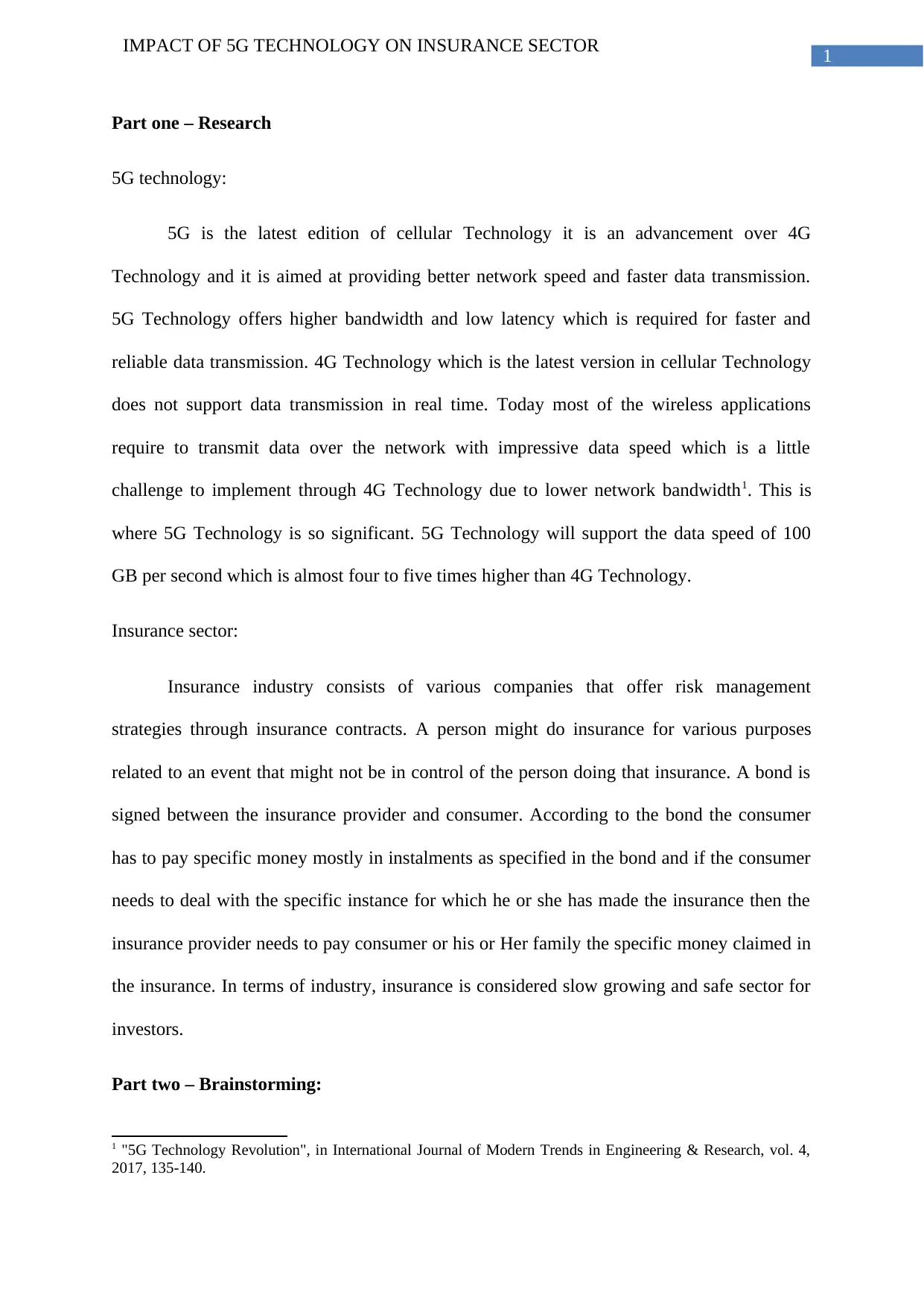
1
IMPACT OF 5G TECHNOLOGY ON INSURANCE SECTOR
Part one – Research
5G technology:
5G is the latest edition of cellular Technology it is an advancement over 4G
Technology and it is aimed at providing better network speed and faster data transmission.
5G Technology offers higher bandwidth and low latency which is required for faster and
reliable data transmission. 4G Technology which is the latest version in cellular Technology
does not support data transmission in real time. Today most of the wireless applications
require to transmit data over the network with impressive data speed which is a little
challenge to implement through 4G Technology due to lower network bandwidth1. This is
where 5G Technology is so significant. 5G Technology will support the data speed of 100
GB per second which is almost four to five times higher than 4G Technology.
Insurance sector:
Insurance industry consists of various companies that offer risk management
strategies through insurance contracts. A person might do insurance for various purposes
related to an event that might not be in control of the person doing that insurance. A bond is
signed between the insurance provider and consumer. According to the bond the consumer
has to pay specific money mostly in instalments as specified in the bond and if the consumer
needs to deal with the specific instance for which he or she has made the insurance then the
insurance provider needs to pay consumer or his or Her family the specific money claimed in
the insurance. In terms of industry, insurance is considered slow growing and safe sector for
investors.
Part two – Brainstorming:
1 "5G Technology Revolution", in International Journal of Modern Trends in Engineering & Research, vol. 4,
2017, 135-140.
IMPACT OF 5G TECHNOLOGY ON INSURANCE SECTOR
Part one – Research
5G technology:
5G is the latest edition of cellular Technology it is an advancement over 4G
Technology and it is aimed at providing better network speed and faster data transmission.
5G Technology offers higher bandwidth and low latency which is required for faster and
reliable data transmission. 4G Technology which is the latest version in cellular Technology
does not support data transmission in real time. Today most of the wireless applications
require to transmit data over the network with impressive data speed which is a little
challenge to implement through 4G Technology due to lower network bandwidth1. This is
where 5G Technology is so significant. 5G Technology will support the data speed of 100
GB per second which is almost four to five times higher than 4G Technology.
Insurance sector:
Insurance industry consists of various companies that offer risk management
strategies through insurance contracts. A person might do insurance for various purposes
related to an event that might not be in control of the person doing that insurance. A bond is
signed between the insurance provider and consumer. According to the bond the consumer
has to pay specific money mostly in instalments as specified in the bond and if the consumer
needs to deal with the specific instance for which he or she has made the insurance then the
insurance provider needs to pay consumer or his or Her family the specific money claimed in
the insurance. In terms of industry, insurance is considered slow growing and safe sector for
investors.
Part two – Brainstorming:
1 "5G Technology Revolution", in International Journal of Modern Trends in Engineering & Research, vol. 4,
2017, 135-140.

2
IMPACT OF 5G TECHNOLOGY ON INSURANCE SECTOR
In order to provide insurance, it is required to collect data about consumers and when
the insurance provider is collecting data of so many consumers, they need to have a
highly efficient and scalable network for accessing data from database especially if it
is deployed in a cloud server. Therefore, insurance companies need to have an
efficient network which requires a huge investment2. However, the introduction of 5G
technology will help companies to have a high-speed reliable network without huge
investment which will definitely improve revenues of these companies through a
reduction in the cost of network infrastructure development
5g network will support advanced data analytics, which is required for collecting data
regarding potential consumers and design insurance policy based on consumer
profiles, which will help insurance providers to customize their insurance policy so
that it is consistent with the consumer requirements thus helping them to deliver their
insurance with greater efficiency3
Integration of 5g technology with IoT devices will have a significant benefit for
insurance companies. The driverless car will become a popular alternative in future to
many consumers and insurance for this driverless car will have a huge demand to the
consumers for which safety is the first priority4. It will be easier for companies to
collect data from different IoT sensor integrated with the driverless car and it will be
helpful to settle issues regarding insurance claim as data from IoT sensors will be
possible to collect in real time due to high-speed network of 5G along with higher
bandwidth and lower latency required for real-time data analysis
2 "IEEE 5G Initiatives Special Issue on 5G Technologies and Applications", in IEEE Vehicular Technology
Magazine, vol. 12, 2017, C2-C2.
3 M McCrea & M Farrell, "A Conceptual Model for Pricing Health and Life Insurance Using Wearable
Technology", in Risk Management and Insurance Review, vol. 21, 2018, 389-411.
4 M Cooper, "5G Technology Briefing", in ITNOW, vol. 60, 2018, 16-20.
IMPACT OF 5G TECHNOLOGY ON INSURANCE SECTOR
In order to provide insurance, it is required to collect data about consumers and when
the insurance provider is collecting data of so many consumers, they need to have a
highly efficient and scalable network for accessing data from database especially if it
is deployed in a cloud server. Therefore, insurance companies need to have an
efficient network which requires a huge investment2. However, the introduction of 5G
technology will help companies to have a high-speed reliable network without huge
investment which will definitely improve revenues of these companies through a
reduction in the cost of network infrastructure development
5g network will support advanced data analytics, which is required for collecting data
regarding potential consumers and design insurance policy based on consumer
profiles, which will help insurance providers to customize their insurance policy so
that it is consistent with the consumer requirements thus helping them to deliver their
insurance with greater efficiency3
Integration of 5g technology with IoT devices will have a significant benefit for
insurance companies. The driverless car will become a popular alternative in future to
many consumers and insurance for this driverless car will have a huge demand to the
consumers for which safety is the first priority4. It will be easier for companies to
collect data from different IoT sensor integrated with the driverless car and it will be
helpful to settle issues regarding insurance claim as data from IoT sensors will be
possible to collect in real time due to high-speed network of 5G along with higher
bandwidth and lower latency required for real-time data analysis
2 "IEEE 5G Initiatives Special Issue on 5G Technologies and Applications", in IEEE Vehicular Technology
Magazine, vol. 12, 2017, C2-C2.
3 M McCrea & M Farrell, "A Conceptual Model for Pricing Health and Life Insurance Using Wearable
Technology", in Risk Management and Insurance Review, vol. 21, 2018, 389-411.
4 M Cooper, "5G Technology Briefing", in ITNOW, vol. 60, 2018, 16-20.
⊘ This is a preview!⊘
Do you want full access?
Subscribe today to unlock all pages.

Trusted by 1+ million students worldwide
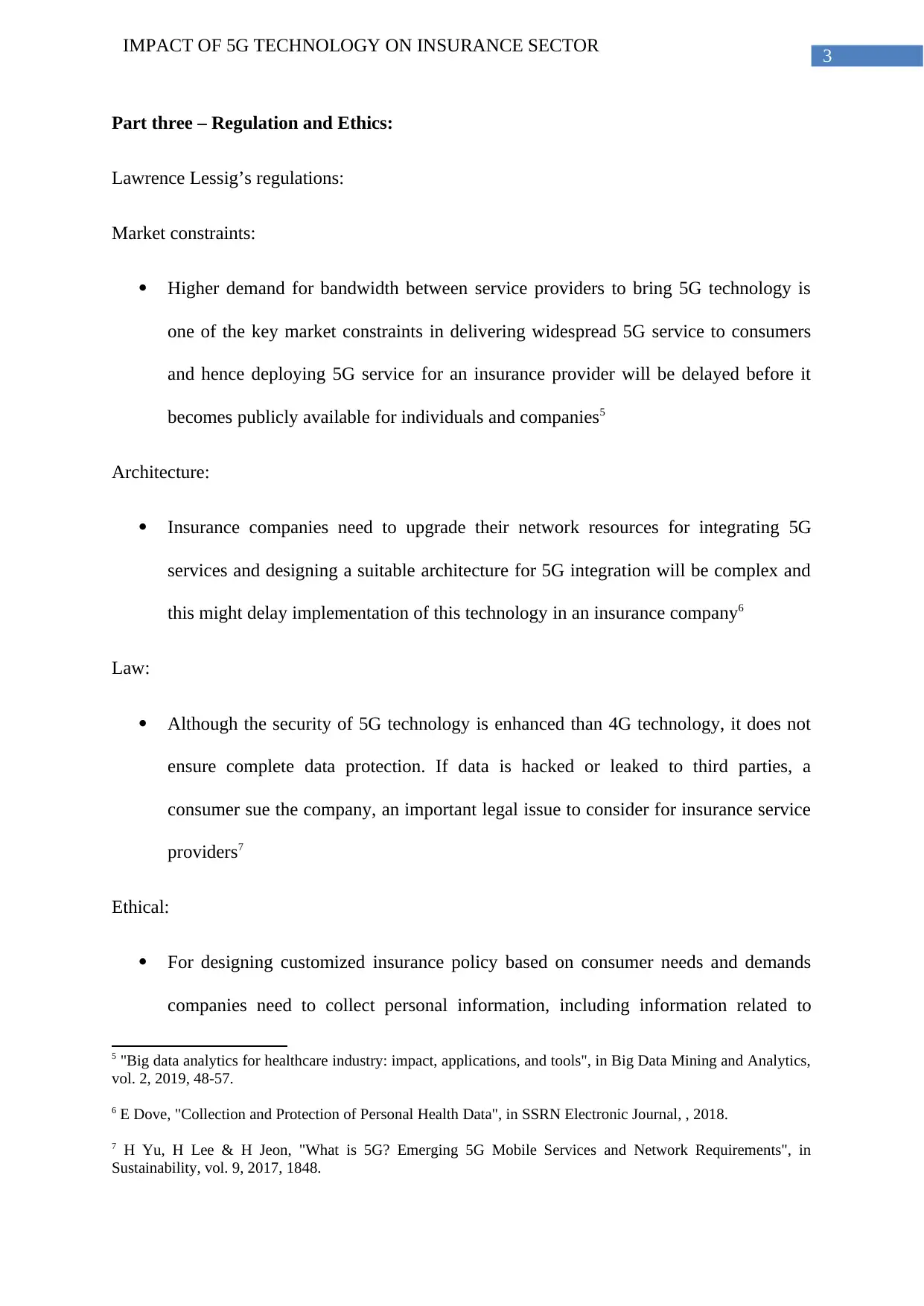
3
IMPACT OF 5G TECHNOLOGY ON INSURANCE SECTOR
Part three – Regulation and Ethics:
Lawrence Lessig’s regulations:
Market constraints:
Higher demand for bandwidth between service providers to bring 5G technology is
one of the key market constraints in delivering widespread 5G service to consumers
and hence deploying 5G service for an insurance provider will be delayed before it
becomes publicly available for individuals and companies5
Architecture:
Insurance companies need to upgrade their network resources for integrating 5G
services and designing a suitable architecture for 5G integration will be complex and
this might delay implementation of this technology in an insurance company6
Law:
Although the security of 5G technology is enhanced than 4G technology, it does not
ensure complete data protection. If data is hacked or leaked to third parties, a
consumer sue the company, an important legal issue to consider for insurance service
providers7
Ethical:
For designing customized insurance policy based on consumer needs and demands
companies need to collect personal information, including information related to
5 "Big data analytics for healthcare industry: impact, applications, and tools", in Big Data Mining and Analytics,
vol. 2, 2019, 48-57.
6 E Dove, "Collection and Protection of Personal Health Data", in SSRN Electronic Journal, , 2018.
7 H Yu, H Lee & H Jeon, "What is 5G? Emerging 5G Mobile Services and Network Requirements", in
Sustainability, vol. 9, 2017, 1848.
IMPACT OF 5G TECHNOLOGY ON INSURANCE SECTOR
Part three – Regulation and Ethics:
Lawrence Lessig’s regulations:
Market constraints:
Higher demand for bandwidth between service providers to bring 5G technology is
one of the key market constraints in delivering widespread 5G service to consumers
and hence deploying 5G service for an insurance provider will be delayed before it
becomes publicly available for individuals and companies5
Architecture:
Insurance companies need to upgrade their network resources for integrating 5G
services and designing a suitable architecture for 5G integration will be complex and
this might delay implementation of this technology in an insurance company6
Law:
Although the security of 5G technology is enhanced than 4G technology, it does not
ensure complete data protection. If data is hacked or leaked to third parties, a
consumer sue the company, an important legal issue to consider for insurance service
providers7
Ethical:
For designing customized insurance policy based on consumer needs and demands
companies need to collect personal information, including information related to
5 "Big data analytics for healthcare industry: impact, applications, and tools", in Big Data Mining and Analytics,
vol. 2, 2019, 48-57.
6 E Dove, "Collection and Protection of Personal Health Data", in SSRN Electronic Journal, , 2018.
7 H Yu, H Lee & H Jeon, "What is 5G? Emerging 5G Mobile Services and Network Requirements", in
Sustainability, vol. 9, 2017, 1848.
Paraphrase This Document
Need a fresh take? Get an instant paraphrase of this document with our AI Paraphraser
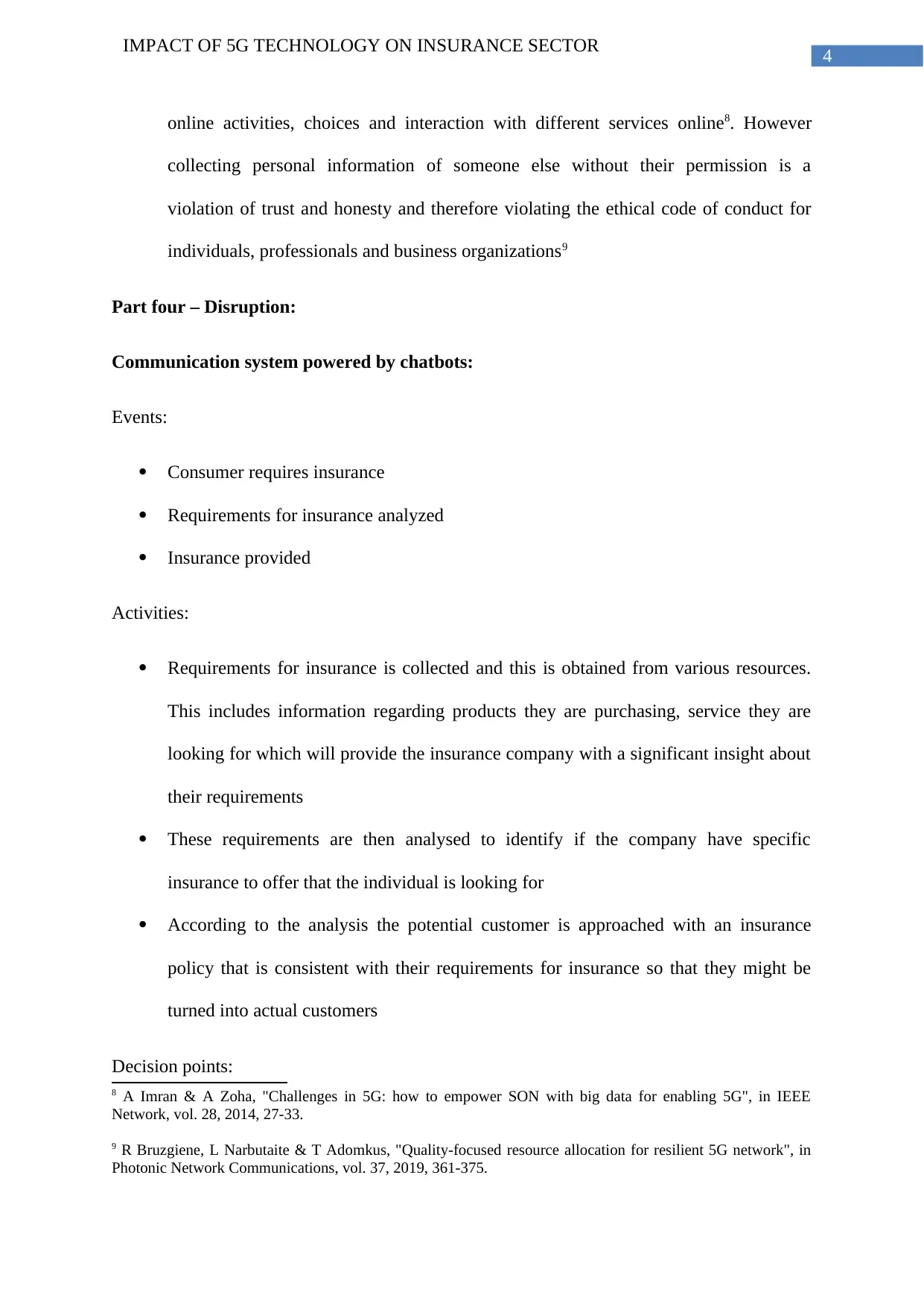
4
IMPACT OF 5G TECHNOLOGY ON INSURANCE SECTOR
online activities, choices and interaction with different services online8. However
collecting personal information of someone else without their permission is a
violation of trust and honesty and therefore violating the ethical code of conduct for
individuals, professionals and business organizations9
Part four – Disruption:
Communication system powered by chatbots:
Events:
Consumer requires insurance
Requirements for insurance analyzed
Insurance provided
Activities:
Requirements for insurance is collected and this is obtained from various resources.
This includes information regarding products they are purchasing, service they are
looking for which will provide the insurance company with a significant insight about
their requirements
These requirements are then analysed to identify if the company have specific
insurance to offer that the individual is looking for
According to the analysis the potential customer is approached with an insurance
policy that is consistent with their requirements for insurance so that they might be
turned into actual customers
Decision points:
8 A Imran & A Zoha, "Challenges in 5G: how to empower SON with big data for enabling 5G", in IEEE
Network, vol. 28, 2014, 27-33.
9 R Bruzgiene, L Narbutaite & T Adomkus, "Quality-focused resource allocation for resilient 5G network", in
Photonic Network Communications, vol. 37, 2019, 361-375.
IMPACT OF 5G TECHNOLOGY ON INSURANCE SECTOR
online activities, choices and interaction with different services online8. However
collecting personal information of someone else without their permission is a
violation of trust and honesty and therefore violating the ethical code of conduct for
individuals, professionals and business organizations9
Part four – Disruption:
Communication system powered by chatbots:
Events:
Consumer requires insurance
Requirements for insurance analyzed
Insurance provided
Activities:
Requirements for insurance is collected and this is obtained from various resources.
This includes information regarding products they are purchasing, service they are
looking for which will provide the insurance company with a significant insight about
their requirements
These requirements are then analysed to identify if the company have specific
insurance to offer that the individual is looking for
According to the analysis the potential customer is approached with an insurance
policy that is consistent with their requirements for insurance so that they might be
turned into actual customers
Decision points:
8 A Imran & A Zoha, "Challenges in 5G: how to empower SON with big data for enabling 5G", in IEEE
Network, vol. 28, 2014, 27-33.
9 R Bruzgiene, L Narbutaite & T Adomkus, "Quality-focused resource allocation for resilient 5G network", in
Photonic Network Communications, vol. 37, 2019, 361-375.
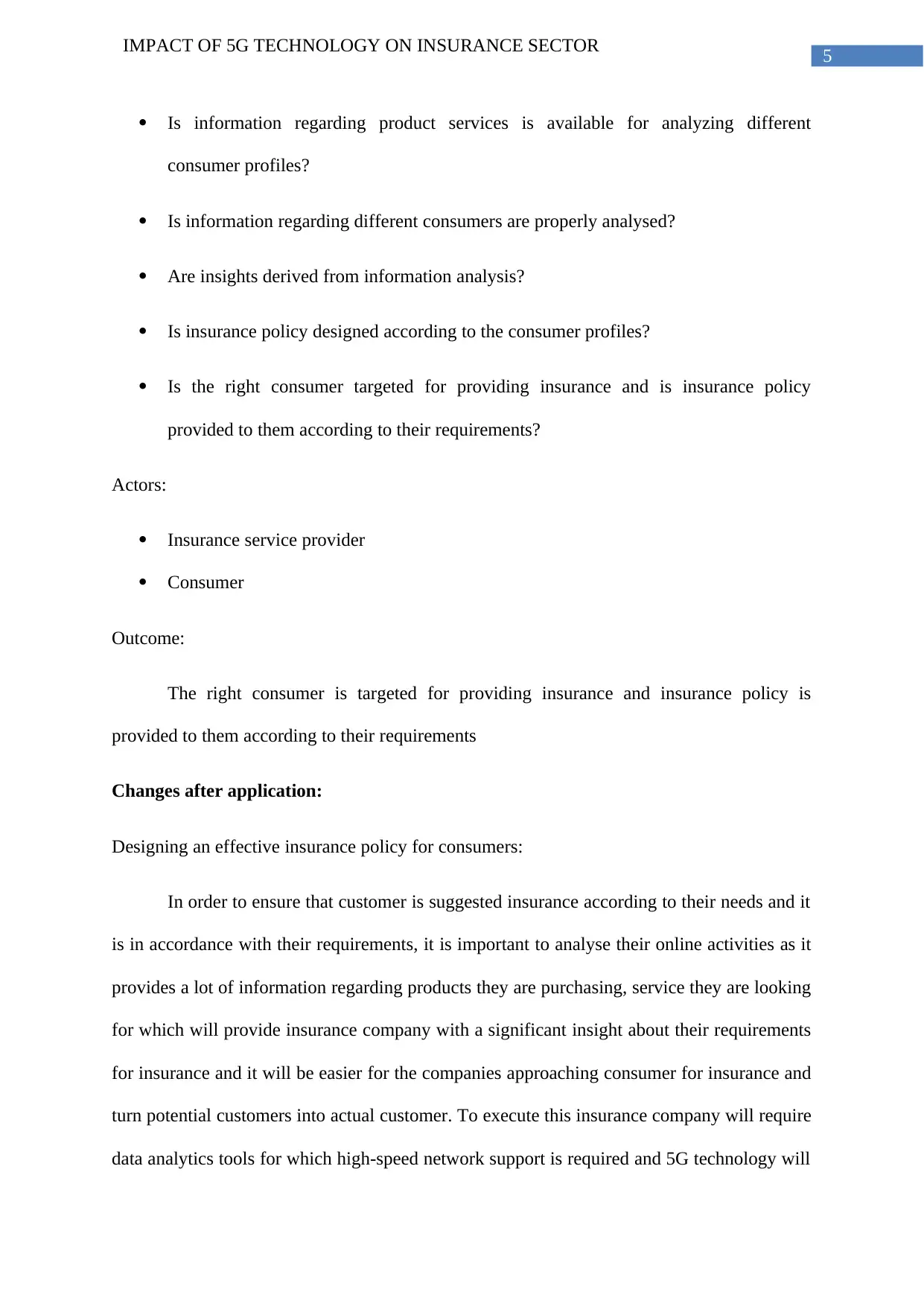
5
IMPACT OF 5G TECHNOLOGY ON INSURANCE SECTOR
Is information regarding product services is available for analyzing different
consumer profiles?
Is information regarding different consumers are properly analysed?
Are insights derived from information analysis?
Is insurance policy designed according to the consumer profiles?
Is the right consumer targeted for providing insurance and is insurance policy
provided to them according to their requirements?
Actors:
Insurance service provider
Consumer
Outcome:
The right consumer is targeted for providing insurance and insurance policy is
provided to them according to their requirements
Changes after application:
Designing an effective insurance policy for consumers:
In order to ensure that customer is suggested insurance according to their needs and it
is in accordance with their requirements, it is important to analyse their online activities as it
provides a lot of information regarding products they are purchasing, service they are looking
for which will provide insurance company with a significant insight about their requirements
for insurance and it will be easier for the companies approaching consumer for insurance and
turn potential customers into actual customer. To execute this insurance company will require
data analytics tools for which high-speed network support is required and 5G technology will
IMPACT OF 5G TECHNOLOGY ON INSURANCE SECTOR
Is information regarding product services is available for analyzing different
consumer profiles?
Is information regarding different consumers are properly analysed?
Are insights derived from information analysis?
Is insurance policy designed according to the consumer profiles?
Is the right consumer targeted for providing insurance and is insurance policy
provided to them according to their requirements?
Actors:
Insurance service provider
Consumer
Outcome:
The right consumer is targeted for providing insurance and insurance policy is
provided to them according to their requirements
Changes after application:
Designing an effective insurance policy for consumers:
In order to ensure that customer is suggested insurance according to their needs and it
is in accordance with their requirements, it is important to analyse their online activities as it
provides a lot of information regarding products they are purchasing, service they are looking
for which will provide insurance company with a significant insight about their requirements
for insurance and it will be easier for the companies approaching consumer for insurance and
turn potential customers into actual customer. To execute this insurance company will require
data analytics tools for which high-speed network support is required and 5G technology will
⊘ This is a preview!⊘
Do you want full access?
Subscribe today to unlock all pages.

Trusted by 1+ million students worldwide
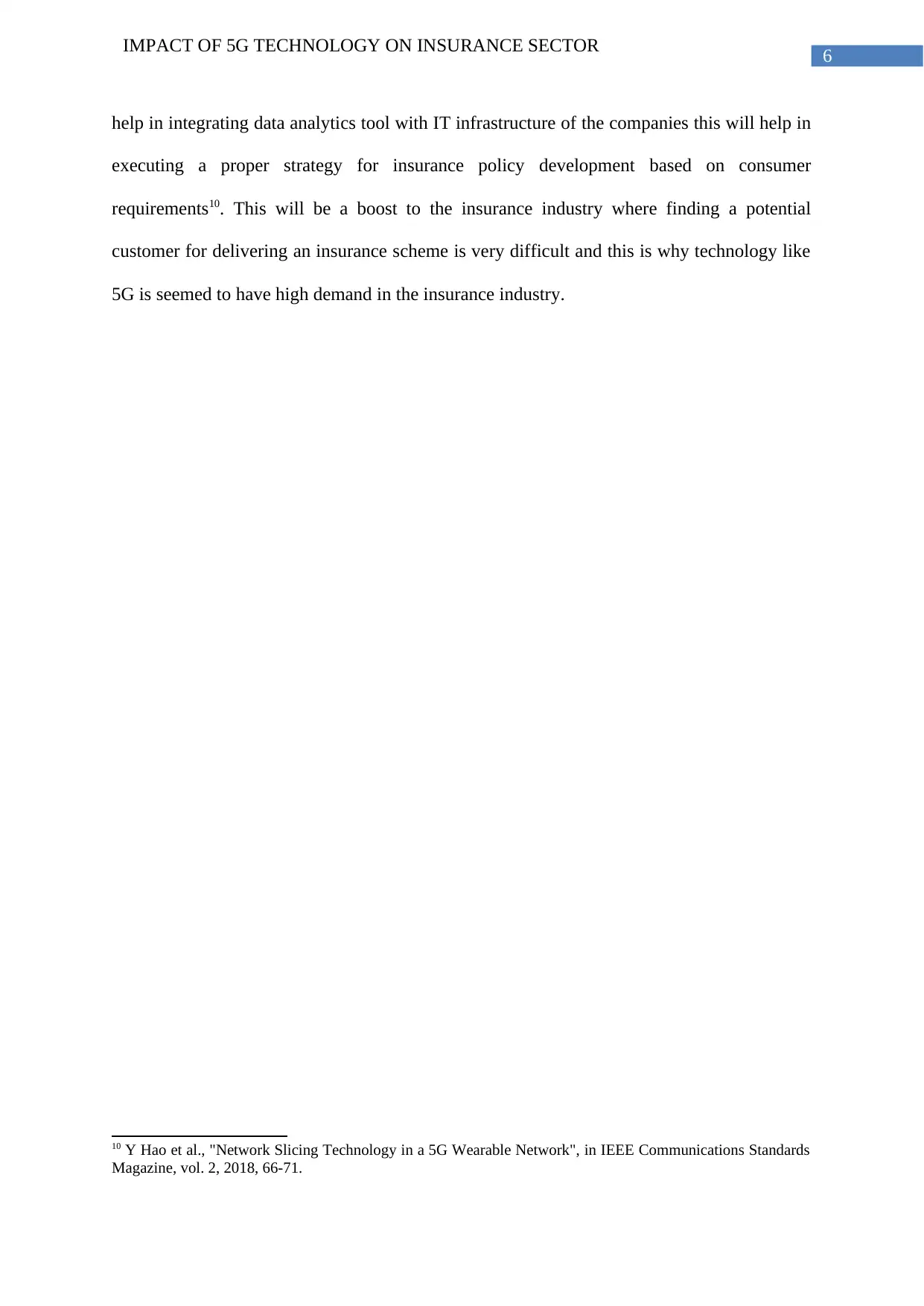
6
IMPACT OF 5G TECHNOLOGY ON INSURANCE SECTOR
help in integrating data analytics tool with IT infrastructure of the companies this will help in
executing a proper strategy for insurance policy development based on consumer
requirements10. This will be a boost to the insurance industry where finding a potential
customer for delivering an insurance scheme is very difficult and this is why technology like
5G is seemed to have high demand in the insurance industry.
10 Y Hao et al., "Network Slicing Technology in a 5G Wearable Network", in IEEE Communications Standards
Magazine, vol. 2, 2018, 66-71.
IMPACT OF 5G TECHNOLOGY ON INSURANCE SECTOR
help in integrating data analytics tool with IT infrastructure of the companies this will help in
executing a proper strategy for insurance policy development based on consumer
requirements10. This will be a boost to the insurance industry where finding a potential
customer for delivering an insurance scheme is very difficult and this is why technology like
5G is seemed to have high demand in the insurance industry.
10 Y Hao et al., "Network Slicing Technology in a 5G Wearable Network", in IEEE Communications Standards
Magazine, vol. 2, 2018, 66-71.
Paraphrase This Document
Need a fresh take? Get an instant paraphrase of this document with our AI Paraphraser
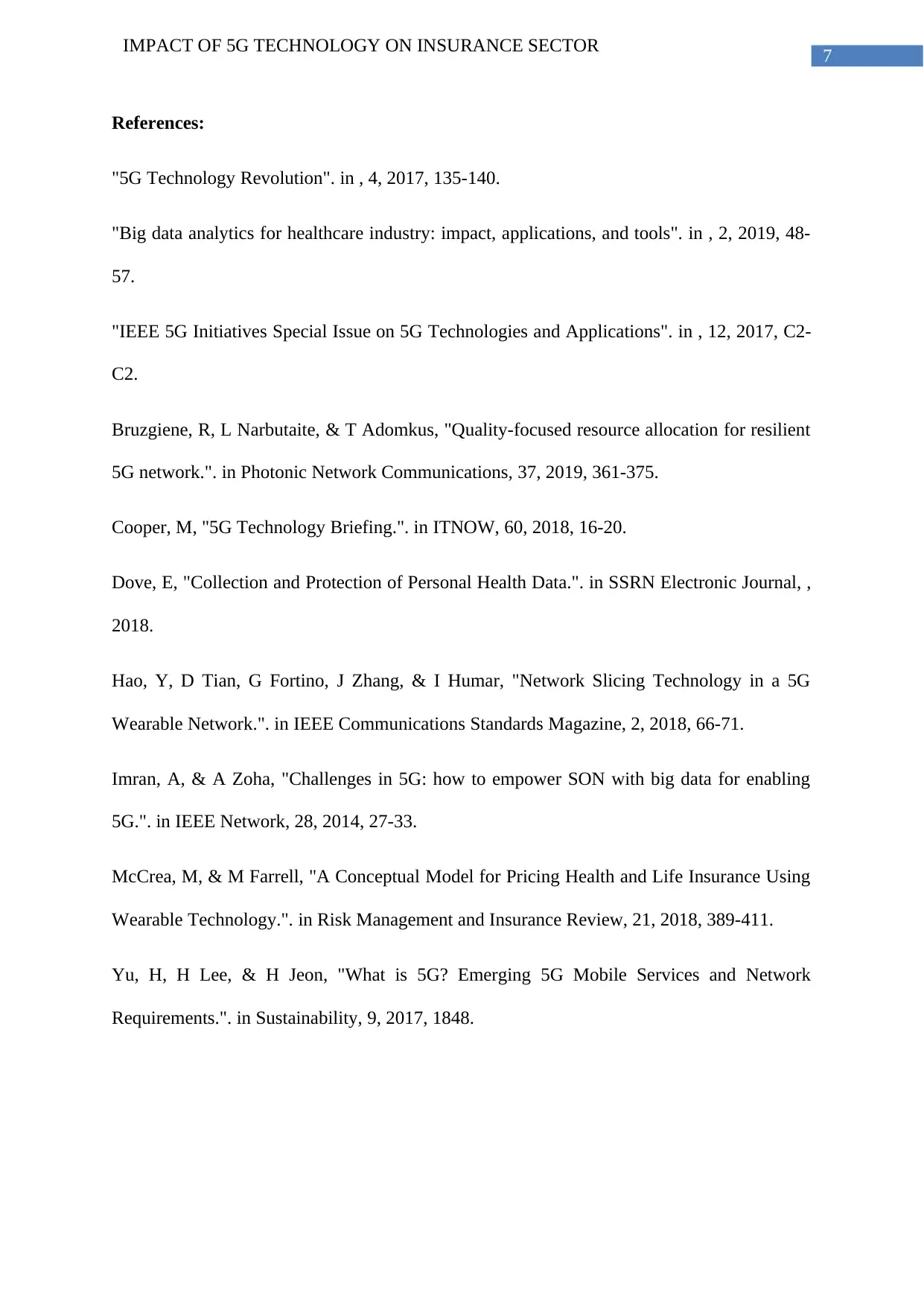
7
IMPACT OF 5G TECHNOLOGY ON INSURANCE SECTOR
References:
"5G Technology Revolution". in , 4, 2017, 135-140.
"Big data analytics for healthcare industry: impact, applications, and tools". in , 2, 2019, 48-
57.
"IEEE 5G Initiatives Special Issue on 5G Technologies and Applications". in , 12, 2017, C2-
C2.
Bruzgiene, R, L Narbutaite, & T Adomkus, "Quality-focused resource allocation for resilient
5G network.". in Photonic Network Communications, 37, 2019, 361-375.
Cooper, M, "5G Technology Briefing.". in ITNOW, 60, 2018, 16-20.
Dove, E, "Collection and Protection of Personal Health Data.". in SSRN Electronic Journal, ,
2018.
Hao, Y, D Tian, G Fortino, J Zhang, & I Humar, "Network Slicing Technology in a 5G
Wearable Network.". in IEEE Communications Standards Magazine, 2, 2018, 66-71.
Imran, A, & A Zoha, "Challenges in 5G: how to empower SON with big data for enabling
5G.". in IEEE Network, 28, 2014, 27-33.
McCrea, M, & M Farrell, "A Conceptual Model for Pricing Health and Life Insurance Using
Wearable Technology.". in Risk Management and Insurance Review, 21, 2018, 389-411.
Yu, H, H Lee, & H Jeon, "What is 5G? Emerging 5G Mobile Services and Network
Requirements.". in Sustainability, 9, 2017, 1848.
IMPACT OF 5G TECHNOLOGY ON INSURANCE SECTOR
References:
"5G Technology Revolution". in , 4, 2017, 135-140.
"Big data analytics for healthcare industry: impact, applications, and tools". in , 2, 2019, 48-
57.
"IEEE 5G Initiatives Special Issue on 5G Technologies and Applications". in , 12, 2017, C2-
C2.
Bruzgiene, R, L Narbutaite, & T Adomkus, "Quality-focused resource allocation for resilient
5G network.". in Photonic Network Communications, 37, 2019, 361-375.
Cooper, M, "5G Technology Briefing.". in ITNOW, 60, 2018, 16-20.
Dove, E, "Collection and Protection of Personal Health Data.". in SSRN Electronic Journal, ,
2018.
Hao, Y, D Tian, G Fortino, J Zhang, & I Humar, "Network Slicing Technology in a 5G
Wearable Network.". in IEEE Communications Standards Magazine, 2, 2018, 66-71.
Imran, A, & A Zoha, "Challenges in 5G: how to empower SON with big data for enabling
5G.". in IEEE Network, 28, 2014, 27-33.
McCrea, M, & M Farrell, "A Conceptual Model for Pricing Health and Life Insurance Using
Wearable Technology.". in Risk Management and Insurance Review, 21, 2018, 389-411.
Yu, H, H Lee, & H Jeon, "What is 5G? Emerging 5G Mobile Services and Network
Requirements.". in Sustainability, 9, 2017, 1848.
1 out of 8
Related Documents
Your All-in-One AI-Powered Toolkit for Academic Success.
+13062052269
info@desklib.com
Available 24*7 on WhatsApp / Email
![[object Object]](/_next/static/media/star-bottom.7253800d.svg)
Unlock your academic potential
Copyright © 2020–2025 A2Z Services. All Rights Reserved. Developed and managed by ZUCOL.




